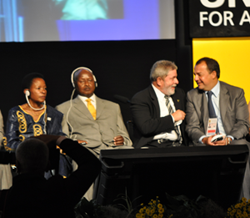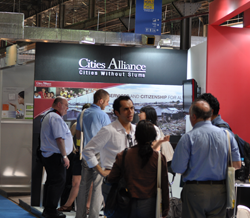
|
| From right: UN-HABITAT Executive Director Anna Tibaijuka, President of Uganda Yoweri Museveni, and Brazilian President Luiz Inacio Lula da Silva. |
[22 March 2010] -- President Luiz Inacio Lula da Silva of Brazil has said Rio is representative of the redevelopment that is taking place all over the country as he welcomed over 15,000 delegates to the fifth World Urban Forum taking place under the theme, ”Bridging the Urban Divide’.
As the country gears up to host major global events like the World Cup in 2014 and the Olympics in 2016, President Lula noted that an overhaul of infrastructure is taking place all over Brazil, particularly in its urban areas where over 80 percent of the population lives.
“We are proving that it is possible to build a new country. I encourage everyone to not only visit our tourist attractions but also visit the favelas and witness what is going on and the positive changes that are occurring,” said President Lula.
Earlier, UN Under-Secretary-General and Executive Director of UN-HABITAT, Mrs. Anna Tibaijuka had spoken of “her delight to be in this beautiful city which is doing so much to bridge the urban divide. “ Following the observation of a minute of silence for the victims of the earthquakes in Haiti and Chile she spoke of the need to constantly raise the profile of urban in the context of rapid and often chaotic urbanisation.
Noting that this was her farewell Forum Mrs. Tibaijuka provided some sobering statistics on urban:
-
There are now over 100 million street children wandering through our cities;
-
Over 200 million people in Sub-Saharan Africa live in slums under dire conditions;
-
South Asia has 35 percent of its people living in slums;
-
Latin America has 24 percent of its people living in slums;
She described the World Urban Forum as a campaign tool and instrument towards raising the profile of cities and the issues resulting from unplanned urbanisation. It is also a platform to celebrate the successes of countries like Brazil, which has done so much to redefine land ownership.
Over the years the event has grown to become the premier urban meeting place in the world. The first World Urban Forum in Nairobi in 2002 attracted only 1,200 people. With the second WUF in Barcelona in 2004, that number grew to over 4,000 people. The third WUF in Vancouver in 2006 had over 10,000 people in attendance. For this fifth edition in Rio records show that over 20,000 people registered, with possibly 15,000 of these showing up.
Mrs. Tibaijuka's sentiments were echoed by Minister Marcio Fortes of the Ministry of Cities, the chief organisers of the Forum, who described it as “one way to attack the problems to ensure sustainable development in the world and not just in poor countries. This is a global issue.”

|
| Visitors to the Cities Alliance booth at WUF 5. |
Other speakers more or less spoke on the need to bridge the urban divide by harnessing the opportunities cities provide. President Yoweri Museveni of Uganda described the city as a very “important stimulus for modernisation.”
The urban population of Uganda is 18 percent of total population but the government had made great strides in enabling the acquisition of the skills necessary for sustainable economic growth in cities.
These include the introduction of Universal Primary Education in 1996 and of Universal Secondary Education a few years later. The effects of all these initiatives are beginning to show in the Ugandan economy.
President Museveni concluded by saluting Mrs. Tibaijuka for her excellent leadership of UN-HABITAT over the past ten years.
Leader of the largest US delegation to the World Urban Forum, Secretary of Housing and Urban Development Shaun Donovan on his own part praised Brazil’s as a model of democracy and spoke of strengthened US-Brazil economic ties. He noted that change in the urban landscape must come from building partnerships and from the ground up, and that American metro areas generate 90 cents out of every dollar in the US economy.
WUF 5 will feature several dialogues as well as networking sessions as well as the exhibition which is spread out over six massive and recently renovated warehouses in the old port of Rio with the spectacular view of the Atlantic ocean and the arch-like and three-kilometer-long Pont Rio-Niteroi. Details of some of these activities will follow on these pages.




